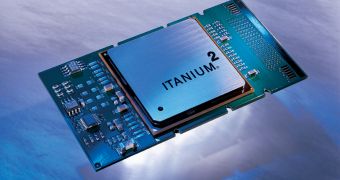Intel’s Itanium architecture was doomed from the start, as it was supposed to battle with Intel’s main bread and butter, the x86 architecture. Itanium’s market, although considerably profitable, was over 20 times smaller than the x86 market and the software base was abysmal.
Many industry insiders saw this and steered away from the Itanium architecture. In fact, everything Itanium does, an Opteron or Xeon server can do better.
That was the main problem: if the performance is the same or worse, why bother with all the troubles with the specific software and very expensive hardware?
Intel continued to pursue the technology hoping to reach a point where the performance would give Itanium a reason for being, but that never happened.
The market was extremely profitable for Intel and also profitable for its partners and thus, Intel left Itanium to continue on its own inertia, as most enterprise applications also come with many years of support.
Once Intel felt that it was ok to stop the Itanium development, rumors started that the architecture was dead and that no more improvements would be made.
This was a logical outcome and Oracle decided to stop making Itanium-compatible software to reduce costs.
Generally, when building specific hardware-optimized software, a company expects that hardware to be on the market for years, so that sales will bring profit and offset the development costs.
Once you know that hardware development and manufacturing is going to stop, it makes no sense to work on software for that specific kind of hardware.
Intel's Itanium was, in fact, mostly a huge amount of hype that swayed many server makers away from Alpha DEC, MIPS, RISC or SPARC to the company's Itanium architecture.
Some companies even went bankrupt because they had dropped their traditional products in favor of Intel's architecture, and one such example is Silicon Graphics.
Once those other architectures were dead and there was clearly no real advantage being offered by using Itanium, Intel started paying less and less attention to the R&D behind its architecture.
Therefore, Oracle decided to announce that they would be no longer going to develop software for Itanium.
Companies that had Itanium-related contracts that spread for multiple years were not happy with the news.
In fact, HP has contracts to maintain and support many Itanium servers and there is rumor that the company has, in fact, paid Intel to keep on developing one more upgrade to the Itanium line.
There is a great deal of money involved and HP doesn’t want its customers to ask for software it has no way of delivering, and thus, HP and Oracle have entered in an argument where the former asked the latter to keep on developing Itanium software.
Now that HP has managed to produce a contract signed by Oracle in 2010 that says the company vows to keep on developing Itanium software, a California state judge ruled on yesterday that Oracle would have to continue supporting and releasing new versions of its software designed for Intel’s Itanium architecture.
Oracle is not going to stay idle and it is likely to fight back, as many say that costs were not the only reason for the company’s move against Itanium.
Oracle has just acquired the historical CPU and software designer Sun and now it’s developing the famous SPARC line of processors that we described here.
The SPARC architecture fights for the same server space that Itanium is in and it doesn’t make any sense for Oracle to develop software to its competitors.
Oracle entered the respective contract back when it had nothing to do with Sun and it was only manufacturing software compatible with as many hardware architectures as possible.
Now, the company has a particular interest in its own SPARC architecture and it would like to get out of old contracts that bind it to make software that would benefit its competitors.

 14 DAY TRIAL //
14 DAY TRIAL //